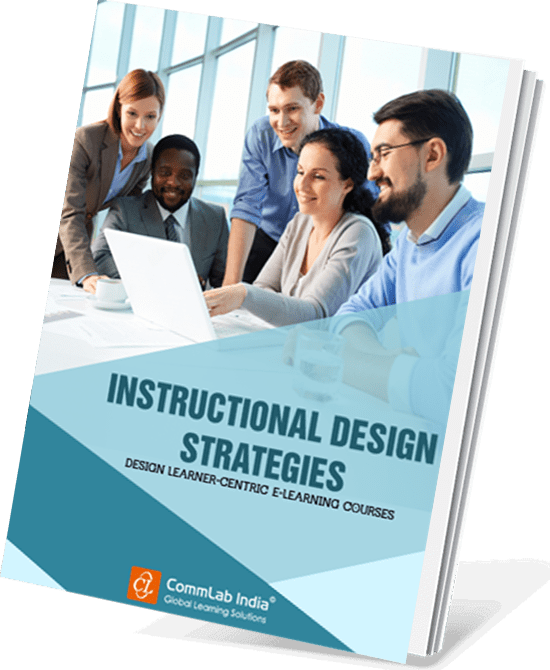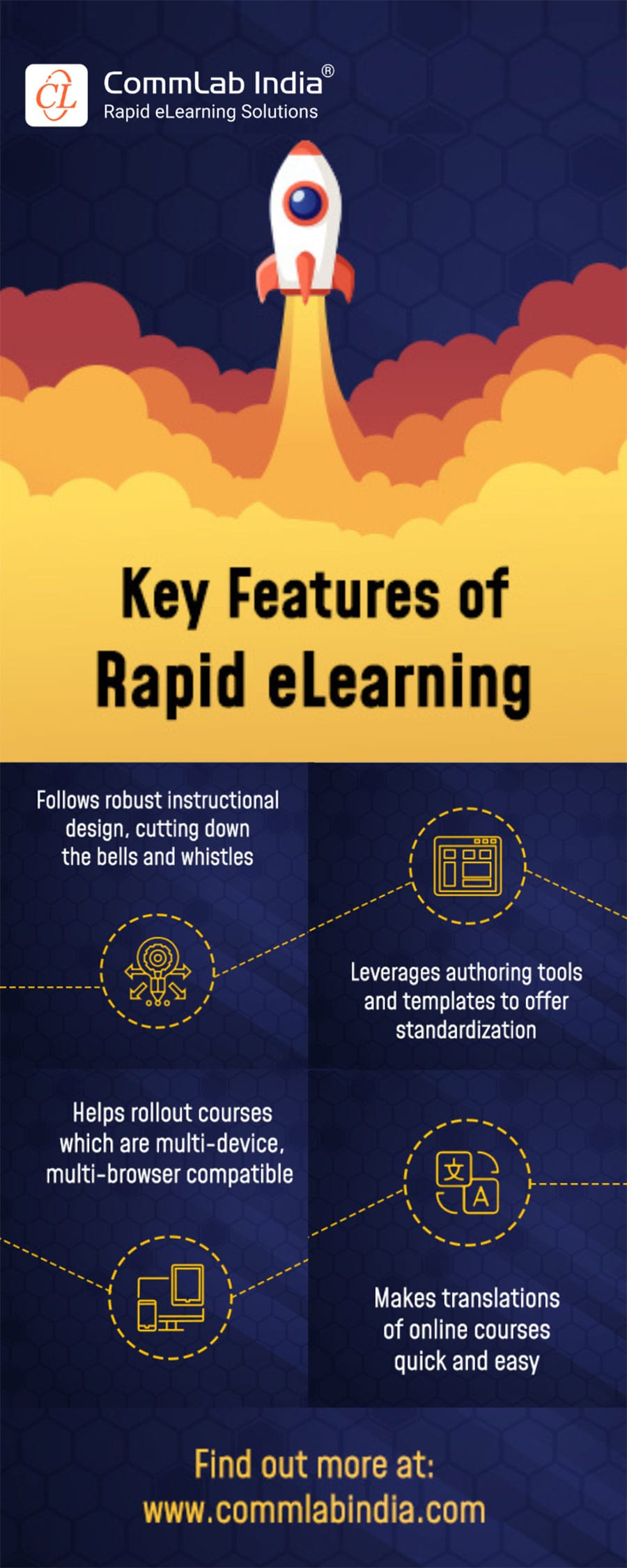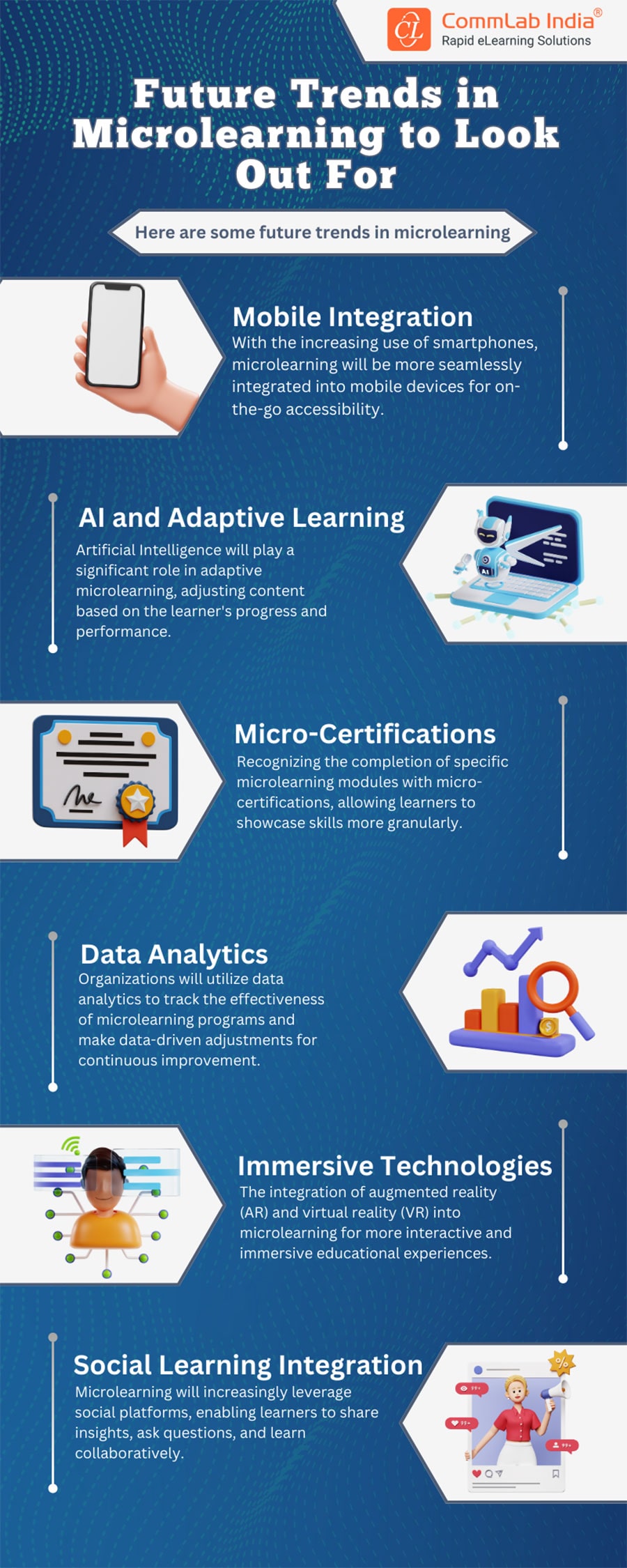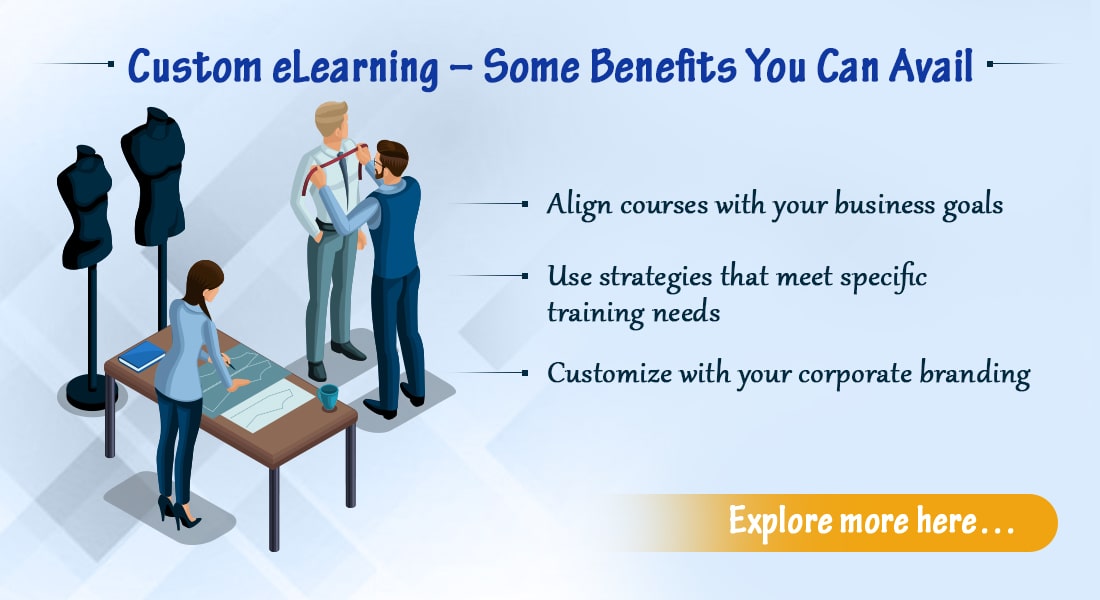Are You Ready for Custom eLearning? Unlock Impactful Corporate Training

The corporate landscape is evolving at an unprecedented pace, and Learning and Development (L&D) Managers, Training Managers in global corporations, need to adapt their training strategies to keep up. Traditional methods of employee training, characterized by one-size-fits-all courses, are becoming obsolete. These outdated approaches fail to engage your workforce effectively and do not equip them with the skills necessary for today’s dynamic environment. That brings us to ‘why custom eLearning?
→ Download Now: Instructional Design Strategies to Design Engaging eLearning Courses
Custom eLearning and the Problems it Addresses
In this fast-changing world, employees need training solutions that are not just relevant, but also engaging and tailored to their unique roles and responsibilities. Custom eLearning is an effective solution to meet these demands. By harnessing the latest strategies and agile development strategies, custom eLearning courses can provide targeted content that address specific skill gaps and align with corporate goals, ultimately driving performance and productivity within your organization.
Bespoke eLearning courses offer personalized learning experiences. Unlike off-the-shelf courses, which often lack relevance, custom solutions can be designed with your organization's culture, values, and specific objectives in mind. This personalization fosters a deeper connection with the material, leading to better engagement and retention of knowledge. Employees are more likely to invest in learning when they see its direct applicability to their roles.
Moreover, custom eLearning allows for a flexible learning environment that accommodates the varying schedules and learning paces of your workforce. Whether employees are in different time zones or have competing responsibilities, eLearning provides the opportunity to learn at their convenience. This flexibility not only enhances participation rates but also empowers employees to take ownership of their development.
Ways to Overcome Global Training Challenges with Custom eLearning
- Say yes to rapid eLearning
- Incorporate videos
- Leverage AI for personalization
- Go micro and mobile
- Gamify and socialize learning
As L&D leaders, you must also consider the importance of incorporating data and analytics into your training programs. Custom eLearning courses provide metrics related to employee progress, engagement levels, and skill acquisition. By leveraging these analytics, you can make informed decisions about future training initiatives and continuously improve the learning experience.
Getting the Best from Custom eLearning Solutions
To truly revolutionize employee training, consider these seven winning hacks for leveraging custom eLearning:
- Conduct comprehensive needs assessments to identify skill gaps.
- Collaborate with subject matter experts to develop relevant content.
- Utilize interactive elements such as quizzes and simulations to boost engagement.
- Integrate microlearning for bite-sized, easily digestible modules.
- Foster a culture of continuous feedback to enhance the learning experience.
- Implement gamification strategies to motivate employees.
- Regularly review and update content to ensure it remains current and applicable.
By implementing these strategies, you can transform your training challenges into triumphs, equipping your workforce with the skills they need to thrive in a rapidly changing corporate landscape. Custom eLearning solutions reshape the way your organization approaches employee development. Embrace this evolution and watch your teams excel.
Navigating the Challenges of Custom eLearning Development
While custom eLearning offers numerous benefits, it also presents distinct challenges that organizations must navigate effectively. One of the primary hurdles lies in the design phase, where creating tailored content that meets the diverse needs of learners can be complex.
Collaborating with subject matter experts (SMEs)
is essential to ensure that the curriculum accurately reflects the required knowledge and skills. However, coordinating with SMEs often involves aligning their expertise with instructional design principles, which can be a time-consuming process.
Balancing the technical constraints of digital platforms and rapid authoring tools adds another layer of complexity. Furthermore, ensuring that the eLearning content remains engaging and relevant while adapting to technological advancements requires continuous effort and innovation. Addressing these challenges head-on is crucial to unlocking the full potential of custom eLearning in an organization.
In addition to the challenges mentioned, several other hurdles may arise when implementing custom eLearning solutions:
Cost and Resource Allocation
Developing tailored eLearning content can be resource-intensive. Organizations need to allocate sufficient budget not only for development but also for ongoing support and updates. This often involves investing in skilled eLearning developers, instructional designers, and technology infrastructure.
Want to augment your team with on-demand L&D skills? Make a successful business case.
User Adoption
Despite the benefits, getting employees to fully embrace and adopt new eLearning tools can be difficult. Change management strategies need to be in place to promote acceptance and usage, specifying what’s in it for the learners.
Data Privacy and Security
With the increase in digital learning, concerns regarding the security of personal data and proprietary content have become prominent. Organizations must ensure that the eLearning platforms they use comply with data protection regulations and have robust security measures in place.
Technology Integration
Integrating custom eLearning with existing systems such as Learning Management Systems (LMS) or Enterprise Resource Planning (ERP) tools can be fraught with compatibility issues. Seamless integration is vital for tracking and reporting purposes but often requires technical expertise to achieve.
Global Accessibility
For multinational corporations, catering to a diverse and geographically dispersed workforce requires consideration of various accessibility concerns such as language accuracy, bandwidth limitations, and cultural differences. And eLearning translations help provide impactful learning experiences in the languages of global learners.
Content Maintenance and Relevance
In a rapidly changing business environment, keeping eLearning content up-to-date and relevant is an ongoing challenge. Regular updates and revisions are necessary to ensure the training reflects current industry standards and practices, requiring a proactive approach to content management.
Addressing these challenges is crucial for harnessing the full potential of custom eLearning and ensuring that training initiatives effectively contribute to organizational goals. Each challenge presents an opportunity for innovation and improvement, ultimately leading to a more robust and effective learning ecosystem.
Overcoming Common Training Challenges with Custom eLearning Solutions
1. Leverage Rapid eLearning
Time is precious, and traditional eLearning development cycles can be cumbersome. Opt for rapid eLearning development that utilizes pre-built templates, agile methodologies, and rapid authoring tools such as Articulate Storyline, iSpring, Easygenerator. This allows you to create high-quality, customized eLearning courses in a fraction of the time, keeping pace with your dynamic business needs.
Why Rapid eLearning?
Rapid eLearning emerges as a transformative approach, particularly beneficial for organizations operating on a global scale. One of its primary advantages is the ability to deliver training swiftly without compromising on quality. By leveraging established templates, agile methodologies, and user-friendly authoring tools, rapid eLearning streamlines the development process, reducing the time and resources typically required for creating extensive learning programs.
Scale and Volume in Global Training
For multinational corporations, training needs are as diverse as their workforce. Rapid eLearning allows companies to scale their training efforts efficiently. The flexibility of rapid eLearning tools enables organizations to develop a higher volume of courses, ensuring that training goals are met across all operational territories. Updating courses or republishing them to a new authoring tool is also easy with rapid eLearning.
Moreover, rapid eLearning facilitates ongoing training initiatives by allowing quick updates to content, keeping pace with industry developments and organizational changes. This adaptability ensures that employees worldwide have access to current, relevant information, which is crucial for maintaining a competitive edge.
With rapid eLearning, global training becomes not only manageable but also strategically advantageous, empowering organizations to develop a knowledgeable and agile workforce.
2. Unleash the Power of Video-based Learning
People connect with stories, and video offers a powerful platform to present information in an engaging and memorable way. Use explainer videos, how-to videos, animated videos, screencasts, and more to capture attention, explain complex concepts, and leave a lasting impression. Think of platforms like Kaltura or Panopto for seamless integration.
How Videos Enhance Custom eLearning Courses
Video content plays a crucial role in custom eLearning courses, offering a dynamic and immersive way to deliver complex information. By integrating various formats of videos, organizations can cater to diverse learning preferences and enhance the overall learning experience.
Videos are excellent tools for illustrating processes and providing demonstrations that might be difficult to convey through text alone. Their ability to combine visual and auditory elements helps learners engage with the material more effectively, aiding in better retention and comprehension of the subject matter.
Moreover, videos can be easily updated, allowing for the inclusion of the latest industry trends and practices, which ensures that learners receive current and relevant information. The use of video content also breaks the monotony of text-heavy courses, making the learning journey more engaging and motivating for participants.
Platforms such as YouTube or Vimeo facilitate easy sharing and accessibility, expanding the reach of training modules. Furthermore, interactive video elements, such as quizzes or clickable annotations, can be incorporated to transform passive viewing to active learning, providing valuable feedback and encouraging learners to apply the concepts in real-time scenarios.
Overall, the integration of video in custom eLearning courses offers a versatile and effective strategy to enrich the learning experience and enhance educational outcomes.
3. Harness AI for Custom eLearning Success
Artificial Intelligence (AI) is enhancing bespoke eLearning design and development by providing tailored experiences that enhance learning outcomes. With its ability to analyze vast amounts of data, AI enables personalized learning paths that address individual needs and preferences.
One of the most significant aspects of AI in eLearning is content creation. AI-driven tools can assist in generating high-quality instructional materials, streamlining the development process, and ensuring content is relevant and engaging.
By analyzing learner interactions and feedback, these tools can suggest updates or new content that aligns with learners' interests and gaps in knowledge, saving time and resources for educators.
Assessments also benefit from AI integration. AI can provide adaptive assessments that adjust in real-time based on the learner's performance. If a learner struggles with a particular concept, the system can present additional questions or resources to reinforce understanding. This personalized approach not only helps learners grasp complex topics but also boosts their confidence and motivation.
In short, the integration of AI in custom eLearning is a game-changer. From content creation to adaptive assessments and personalized learning paths, AI enhances the effectiveness of learning and provides learners the support they need to succeed. Embracing these AI-driven solutions can elevate eLearning experiences, making them more engaging, effective, and tailored to individual needs.
4. Go Micro (and Mobile): Bite-Sized Learning on the Go
Attention spans are shrinking, and mobile devices are ubiquitous. Deliver customized bite-sized learning modules accessible on any device through microlearning. Think of short, focused bursts of information that employees can consume during commutes, coffee breaks, or even between tasks.
Advantages and Popular Formats of Customized Microlearning Courses
Customized microlearning courses offer a myriad of benefits, particularly in addressing the fast-paced and ever-evolving needs of contemporary learners. One of the primary advantages of microlearning is its ability to provide just-in-time training, enabling learners to acquire specific skills or information at the moment of need. This kind of learning is especially effective in the workplace, where employees can quickly apply new knowledge to their tasks, resulting in a more agile and responsive workforce.
Additionally, microlearning improves knowledge retention by delivering information in small, manageable chunks. The human brain processes and retains smaller portions of information more effectively than large volumes of data presented all at once. By breaking down complex subjects into short modules, learners can absorb and understand content better, leading to improved long-term retention and application.
Microlearning also adapts well to modern learners' lifestyles. With mobile devices increasingly used for consuming content, microlearning modules can be accessed anytime, anywhere, fitting seamlessly into busy schedules. This convenience means that learning can occur during typical downtime moments, such as during a commute or lunch break, thus optimizing productive use of time.
Popular formats for microlearning include short instructional videos, infographics, quizzes, and interactive games. Videos can succinctly explain a process or concept and are particularly engaging due to their visual and auditory elements. Infographics distil vast amounts of information into visually appealing graphics, making data comprehensible and memorable.
Quizzes offer an engaging way to reinforce learning and provide immediate feedback, which enhances the retention of information. Games, on the other hand, harness the power of play to create an immersive and motivating learning experience. These formats cater to different learning preferences and can be mixed and matched to suit the needs of diverse learners.
Furthermore, the customization aspect of microlearning is crucial. Tailoring content to fit the specific needs and contexts of the learners ensures relevance and maximizes impact. This customization can be achieved by incorporating company-specific case studies, industry terminology, or relatable scenarios that resonate with learners' everyday experiences.
As a result, customized microlearning courses not only deliver engaging and effective training but also align with organizational goals and strategies, making them an invaluable tool in professional development.

Instructional Design Strategies to Design Engaging eLearning Courses
Design Learner-Centric eLearning
- Importance of ID Strategies in eLearning
- Parameters to Select the Right ID Strategy
- ID Strategies for Effective Results
- Case Studies
5. Gamify and Socialize the Experience
Stimulate learner engagement by capitalizing on the motivational edge of competition through the integration of gamification elements into your custom eLearning content. Immerse participants in a dynamic learning experience by thoughtfully incorporating points, badges, leaderboards, and challenges.
For instance, envision a scenario where sales teams dive into a product knowledge training expedition. The inclusion of gamified challenges and leaderboards not only fuels individual motivation but also sparks healthy competition among peers, fostering a culture of continuous improvement.
As participants strive to earn badges and accumulate points, the learning process becomes an exhilarating journey, cultivating a sense of achievement and making the educational endeavor both enjoyable and impactful.
6. Focus on Collaboration and Peer Learning
Learning is a dynamic process that flourishes within a collaborative ecosystem. Foster a culture of collaboration by seamlessly integrating forums, discussion boards, and live chat features into your custom eLearning solutions. Imagine a scenario where a newly onboarded employee faces a complex task. With discussion boards, they can post queries and tap into the wealth of knowledge within the organization, creating a vibrant exchange of ideas.
Additionally, harness the power of peer-to-peer learning by empowering seasoned employees to share their expertise and mentor their colleagues. This not only enriches the learning experience but also creates a supportive community, where knowledge flows organically, enhancing overall team competence.
Measuring the Impact of Custom eLearning
Measuring the impact of custom eLearning courses is crucial for ensuring that training programs effectively meet organizational goals and enhance learner outcomes. Data serves as your guidepost, allowing you to assess the effectiveness of your eLearning solutions. By leveraging advanced analytics, you can track learner progress, identify areas for improvement, and evaluate the overall impact of your training initiatives.
To measure the effectiveness of custom eLearning, consider the following methods:
- Pre-and Post-Assessment: Conduct assessments before and after the training to gauge knowledge gains and skill acquisition.
- Learner Feedback: Gather feedback through surveys and interviews to understand the learner experience and areas for enhancement.
- Engagement Metrics: Monitor engagement levels using metrics such as course completion rates and time spent on each module.
- Performance Tracking: Use performance metrics to evaluate how well learners apply their new skills in real-world scenarios.
Artificial Intelligence (AI) and Learning Management Systems (LMS) play a significant role in measuring and enhancing custom eLearning. AI can analyze data to provide insights into learning patterns, helping you personalize training experiences. Meanwhile, an LMS facilitates the collection and analysis of performance metrics, making it easier to adapt your learning strategies in real-time.

Instructional Design Strategies to Design Engaging eLearning Courses
Design Learner-Centric eLearning
- Importance of ID Strategies in eLearning
- Parameters to Select the Right ID Strategy
- ID Strategies for Effective Results
- Case Studies
By continuously measuring and adapting your custom eLearning solutions, you can ensure they remain aligned with your evolving business goals and effectively support the growth and development of your learners.
Wrapping Up
Before saying bye, we want to remind you that L&D isn't just about delivering content; it's about creating impactful learning experiences that drive success. By embracing cutting-edge L&D trends and partnering with the right custom eLearning providers, you can transform your training from a chore into a catalyst for change, empowering your workforce with the skills and knowledge they need to thrive in today's competitive landscape.
- Incorporate flexible learning paths to accommodate diverse skill levels and learning paces, ensuring that each learner can engage at their own speed and revisit content as needed.
- Utilize real-world scenarios and simulations in custom courseware to provide contextual learning experiences, bridging the gap between theoretical knowledge and practical application.
- Ensure content accessibility for all learners by adhering to inclusive design principles and providing multiple formats, such as transcripts for video content and text-to-speech options.
- Foster a culture of continuous feedback by implementing regular surveys and assessments to gather learner input, providing opportunities for iterative improvements to the learning program.
P.S.: Don't underestimate the power of a solid instructional design. Even with all the technology at your disposal, a well-structured, learner-centric approach is crucial for creating truly effective custom eLearning solutions. Explore more about instructional design and ID strategies that lead you to success in our eBook given below. Download now!







